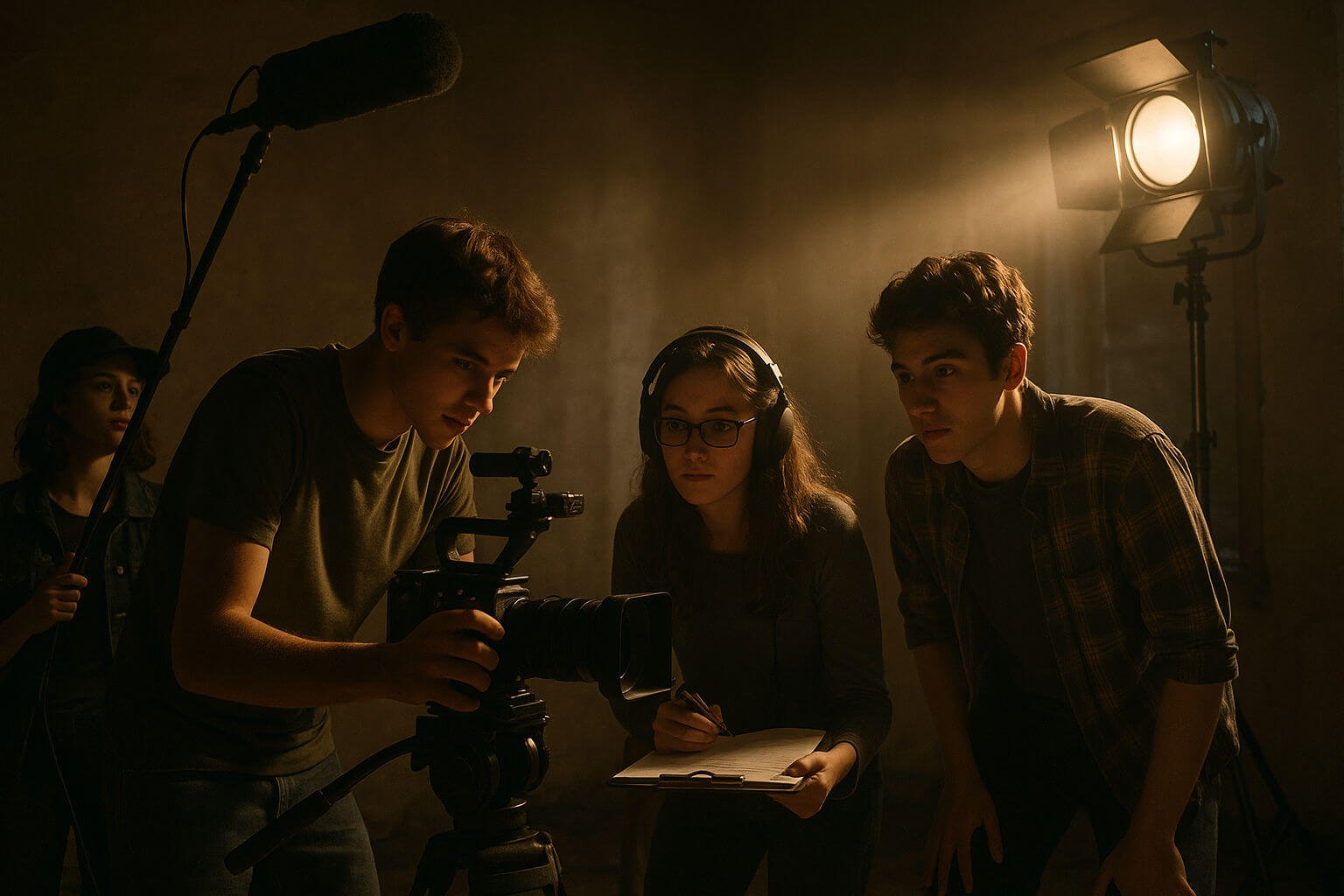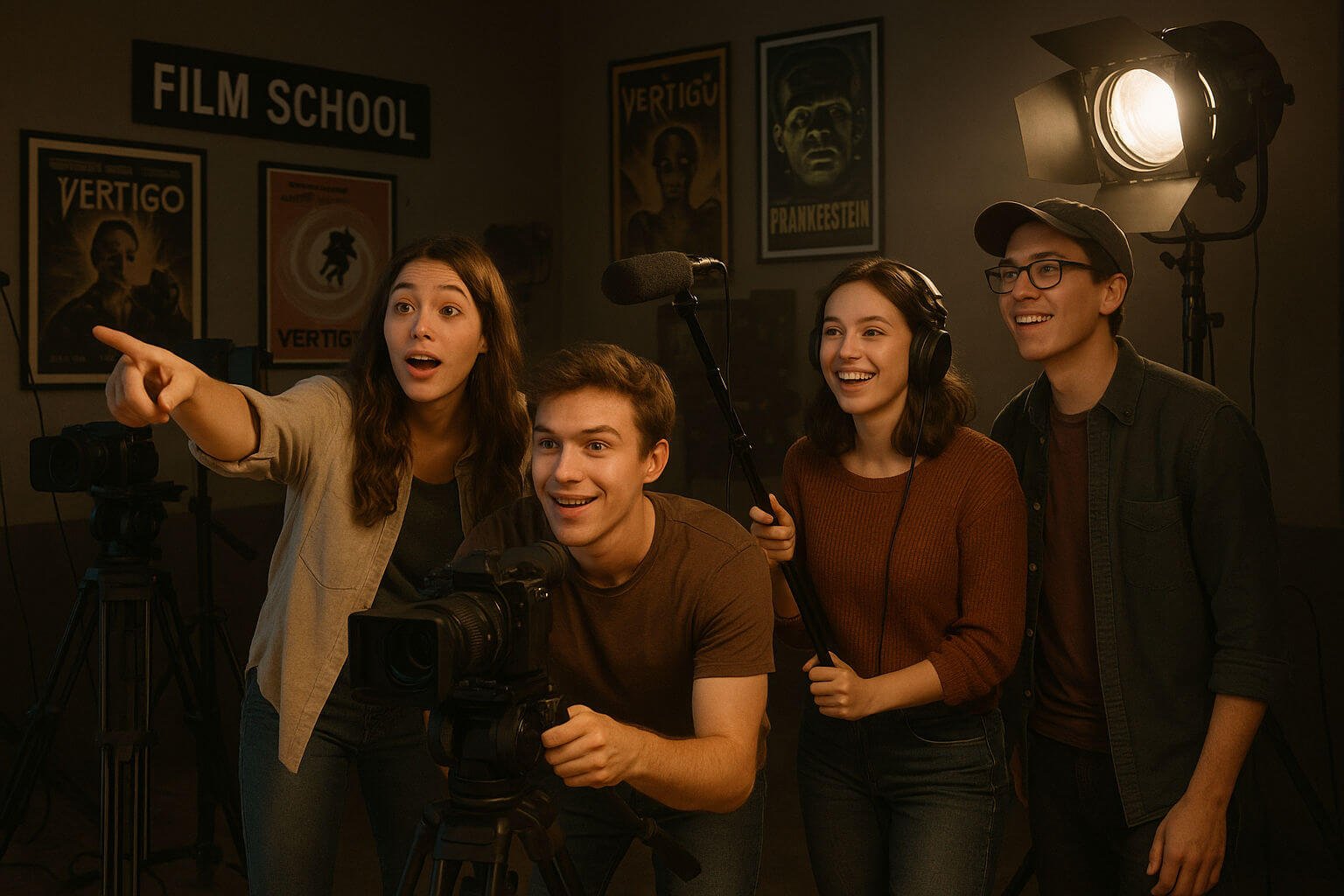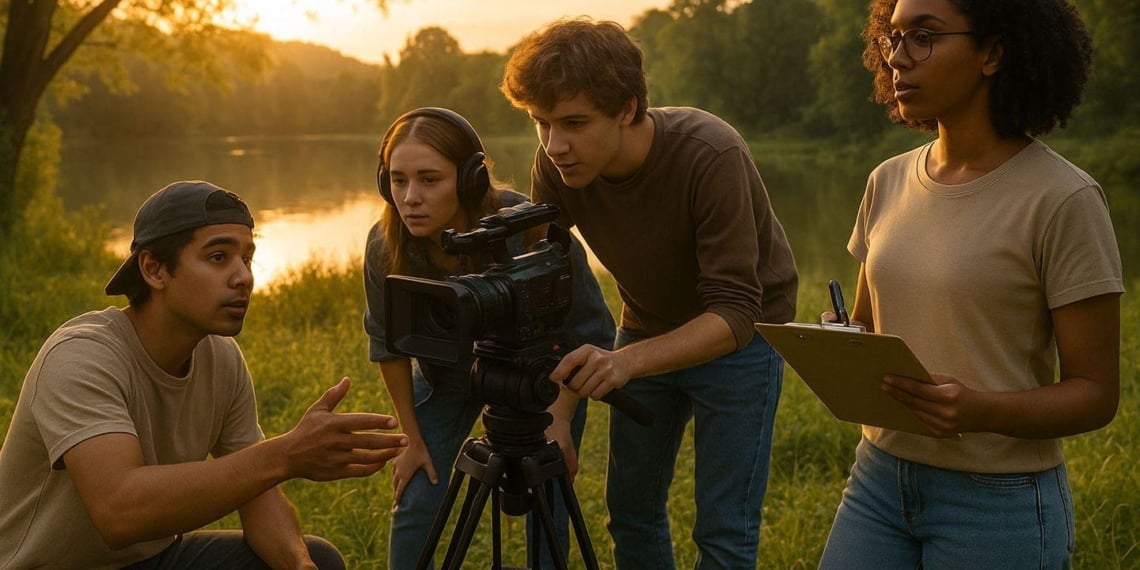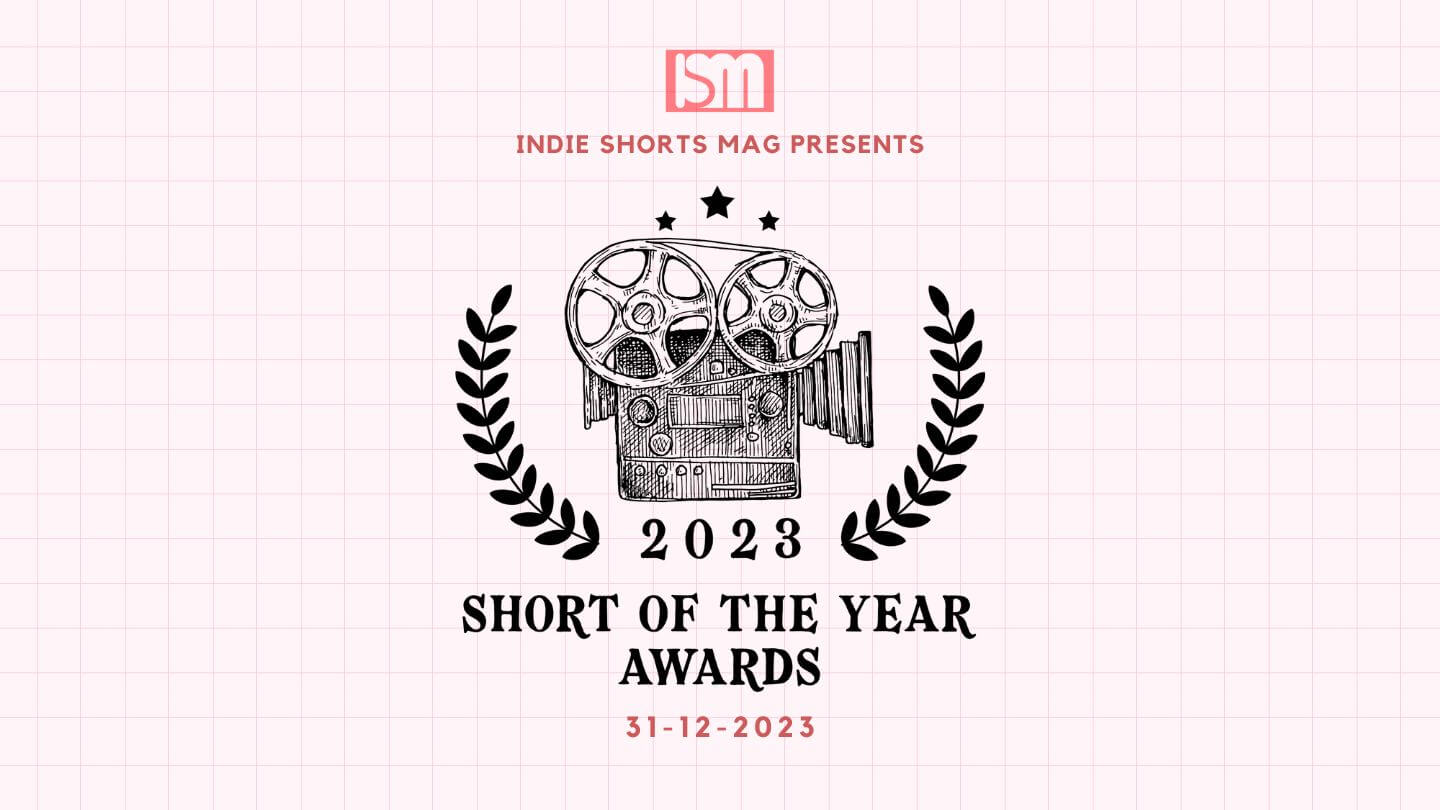Creating a short film can be challenging, but avoiding these 10 common mistakes can save you time, money, and stress:
- Overcomplicated Scripts: Keep your story simple and focused. Use the 3 Cs – Character, Conflict, and Change – to create depth without overloading the narrative.
- Skipping Pre-Production: Thorough planning, including storyboarding, budgeting, and location scouting, is key to avoiding chaos during filming.
- Bad Audio: Invest in quality microphones and record clean sound. Poor audio can ruin your film faster than shaky visuals.
- Wrong Lighting: Use proper lighting techniques to set the mood and ensure your shots look professional, even on a budget.
- Neglecting Production Design: Pay attention to sets, props, and costumes to make your film visually engaging and believable.
- Continuity Errors: Track details like props, costumes, and actor movements to maintain consistency across scenes.
- Overusing Camera Effects: Keep camera movements purposeful and avoid excessive effects that distract from the story.
- Doing Everything Yourself: Build a small, reliable team to share responsibilities and improve your film’s quality.
- Skipping Actor Rehearsals: Rehearse with your cast to refine performances and ensure on-screen chemistry.
- Rushing Post-Production: Allocate enough time for editing, sound design, and color grading to produce a polished final product.
Quick Comparison of Key Equipment
| Category | Budget Options | Mid-Range Options | High-End Options |
|---|---|---|---|
| Audio | Boya BY-M1 ($15), Rode VideoMic GO II (<$100) | Zoom H5 ($280) | Aputure Deity S-Mic 2 ($359) |
| Lighting | DIY LED Kits (<$40) | Budget LED Panels (<$200) | High-End LED ($1,500+) |
10 Common Mistakes New Filmmakers Make & How to Avoid Them
1. Writing Scripts That Are Too Complex or Unrealistic
One common misstep for first-time filmmakers is trying to cram too much into their short film scripts. Unlike feature films, which have the luxury of 90 to 120 minutes to explore multiple plotlines, short films require a razor-sharp focus.
Another pitfall is leaning on far-fetched plot twists. These "only in the movies" moments often feel predictable to seasoned audiences who’ve seen similar tropes play out countless times. Overcomplicating a story can also dilute its emotional impact. The more layers you add, the harder it becomes for viewers to connect with your characters or the core message.
Instead, aim for simplicity. Build your story around one strong concept that resonates emotionally or intellectually. Think of your script like a laser beam – focusing all your energy on a single theme will yield a much stronger result than scattering ideas across multiple threads.
A great way to achieve this is by sticking to the three Cs: Character, Conflict, and Change. Start with a compelling character who faces a clear challenge, and then show how they grow or change through that struggle. This method allows you to create depth without overloading the narrative, making it easier for your audience to stay engaged.
Simplicity doesn’t mean sacrificing creativity – it’s about clarity. Use visual storytelling to convey complex ideas through actions and expressions rather than lengthy dialogue. For example, focus on showing rather than telling. Keep action sequences concise – try to limit them to three lines or less – and let your characters’ appearances and behaviors reveal their roles in the story. This keeps your script tight and impactful.
Believability is also key. By grounding your story in logical, relatable choices, you avoid falling back on overused clichés and instead find fresh, authentic solutions. This commitment to realism not only makes your story more engaging but also helps it stand out from the crowd.
Short films thrive on efficiency. By streamlining your script during the writing process, you’ll save yourself time, money, and stress when it comes time to produce. A focused, well-edited script is the foundation of a successful short film.
2. Skipping Pre-Production Planning
Diving straight into filming without proper preparation can be a recipe for disaster. It often leads to costly mistakes, a disjointed creative process, and results that fall short of expectations.
Why Poor Planning Costs You
Neglecting pre-production doesn’t just waste time – it drains your budget. Without a clear plan, you risk creating a film that strays from your vision, suffers from subpar production quality, or fails to connect with your audience. Mike Gasaway sums it up perfectly:
"The reality is that success is 90% in the planning and 10% in the execution".
Key Steps for Pre-Production
To avoid chaos, start by finalizing your shooting script. Break it down scene by scene, identifying everything you’ll need – actors, props, costumes, locations, and any special effects. This breakdown acts as your blueprint for the entire project.
Next, establish a realistic budget and production schedule that aligns with your resources and constraints. Location scouting should be a priority – secure your spots early and account for lighting conditions, accessibility, and permits. Many filmmakers underestimate how much time this step takes, but it’s crucial for a smooth shoot.
Once the logistics are in place, shift your attention to visualizing your film.
Bringing Your Vision to Life
Storyboarding and creating detailed shot lists are essential tools during pre-production. As Martin Scorsese puts it:
"The storyboard is the way to visualize the entire movie in advance".
These tools not only help you map out your narrative but also ensure that your crew understands your vision, making it easier to capture every necessary shot.
Using Digital Tools for Efficiency
Digital tools like StudioBinder and Milanote can simplify your pre-production process. StudioBinder helps with production management, while Milanote offers templates to organize your ideas and plans in one place.
Why Pre-Production Matters
The more effort you put into pre-production, the fewer headaches you’ll face during filming. Careful planning allows you to tackle technical details like lighting and sound setups in advance, ensuring productive shoot days. It also frees you to focus on the creative aspects – capturing powerful performances and stunning visuals.
In short, pre-production is your safety net. It keeps technical issues, budget overruns, and creative missteps at bay, ensuring your vision comes to life as planned.

3. Recording Bad Audio
Bad audio can ruin even the most stunning visuals. While audiences might tolerate shaky footage or slightly out-of-focus shots, poor sound quality often drives them away almost instantly. Patrick Winters, author of Sound Design for Low and No Budget Films, puts it plainly:
"There’s nothing that turns off an audience faster than bad sound. An image can be a bit soft in focus or a bit shaky, and the audience is accepting, but when the sound is bad, they’re often intolerant."
Common Causes of Poor Audio
Filmmakers often get so wrapped up in achieving the perfect shot that they overlook critical audio issues. The result? Dialogue drowned out by sound effects, echoes, distracting background noise, or interference. Add to that problems like wind distortion, clothing rustle, or improper microphone use, and you’ve got a recipe for a costly post-production headache. Recognizing these issues early is essential to avoid escalating expenses later.
Why Investing in Audio Matters
Here’s a surprising fact: roughly 70% of a movie’s audio is created or refined during post-production. Skimping on your audio budget can lead to rushed studio sessions or reliance on generic fixes instead of tailored sound design.
The good news? You don’t need to break the bank to capture high-quality sound. Affordable options like the Zoom H5 Handy Recorder ($280), the Rode VideoMic GO II (under $100), or the Audio-Technica ATR3350 lavalier mic (about $21) can deliver excellent results. And as filmmaker Markus Innocenti advises:
"Don’t rely on the mic built into your camera. That’s rule #1."
Simple Techniques for Better Audio
Start by setting your audio format to WAV 48kHz/24bit and aim for input levels peaking at -12dB to ensure clean recordings. Don’t forget to capture room tone for seamless sound editing, and use wind or pop filters to minimize unwanted noise.
The Magic of Seamless Sound
Sound designer Kieran Kaye captures the essence of good audio:
"Good sound is invisible."
When sound blends effortlessly with visuals, it enhances the story without drawing attention to itself. Prioritizing audio alongside visuals can elevate your film’s production value and create a fully immersive experience for your audience.
4. Using Wrong Lighting Methods
Lighting can make or break a short film. While many filmmakers get caught up in camera specs or pricey lenses, they often overlook a fundamental element: lighting shapes everything your audience sees and feels. Neglecting this can leave even the most promising visuals looking flat or unprofessional.
The Most Common Lighting Mistakes
Some frequent lighting errors include using too little light, which results in murky, amateurish scenes, or overusing harsh light, creating jarring contrasts. Another common issue is flooding a scene with uniform light, which flattens the image and robs it of depth. Mixing different color temperatures is another pitfall, leading to unnatural skin tones and distracting shifts in color.
Photographer Malleus Veritas captures the essence of lighting’s importance:
"Photography literally means ‘writing with light.’ No light = no photograph. Bad light = bad photograph."
This underscores why understanding and applying proper lighting techniques is so critical.
Why Lighting Deserves More Attention
Lighting is more than just a technical detail – it’s a storytelling tool. Studies show that 93% of communication is nonverbal. Poor lighting not only makes your film harder to watch but also creates a disconnect between your audience and your characters. It can distract viewers and undermine the emotional impact of your story.
Robert Jackson, an amateur filmmaker and wedding videographer, explains:
"Light is emotional and subtle. Rarely are we thinking about it when we watch a film, but it is rare when all light in a shot is not planned out painstakingly around the story telling."
When done thoughtfully, lighting becomes an invisible yet powerful force that enhances the narrative.
Budget-Friendly Lighting Solutions
You don’t need a Hollywood budget to achieve professional-grade lighting. In fact, good lighting often matters more than expensive camera gear. With a modest investment, you can create a DIY lighting kit for under $100 using supplies like clip lights, LED bulbs, and clothespins. For a more complete setup, $150 can cover additional essentials like reflectors and diffusers.
Start with a three-point lighting setup: position a key light at a 45° angle to your subject, use a white board or reflector for fill, and add a backlight to separate the subject from the background. This simple arrangement instantly adds depth and clarity to your shots.
Quick Tips for Better Lighting
- Soften harsh shadows by diffusing light. A white shower curtain or a bounce off a white surface can work wonders.
- Make a DIY reflector by crumpling tinfoil over a rigid surface.
- Keep color temperatures consistent. Use your camera’s white balance settings or gels to match light sources for accurate colors.
- When shooting outdoors, avoid the harsh midday sun. Opt for early morning or late afternoon when the light is naturally softer, or shoot in shaded areas for even diffusion.
As Film & Learning puts it:
"Good lighting is the unsung hero that sculpts faces, creates mood, and separates your subject from the background, adding a professional depth that no camera sensor, no matter how pricey, can achieve in a vacuum."
Finally, always prioritize safety when working with DIY setups. Secure your lights properly and watch out for heat from bulbs. Just like pre-production planning prevents headaches, mastering lighting ensures your visuals fully support your story.
5. Ignoring Production Design and Styling
Just like sound and lighting, production design plays a critical role in achieving a professional look for your film. Yet, many filmmakers overlook this aspect, even though it has the power to elevate a short film from average to exceptional.
Production design covers everything that appears on screen – set design, props, costumes, and visual effects. It shapes the world of your film, making it feel genuine and immersive. When done well, it becomes an unspoken storytelling tool, conveying emotions and character depth without relying on dialogue.
Why Production Design Deserves Attention
Take a film like Amélie. Its vivid colors and whimsical sets transport viewers into a unique world. Similarly, period films rely on authentic costumes and locations to pull audiences into a specific time. These details create a sense of realism and engagement that keeps viewers hooked. Neglecting production design, on the other hand, can undermine your film’s entire impact.
Common Pitfalls in Production Design
One of the biggest mistakes is treating sets as mere backdrops rather than integral parts of the story. Another misstep is overloading the set with too many details, making it visually overwhelming and distracting from the narrative. Inconsistent design choices – like placing a financially struggling character in an overly luxurious setting – can also break the audience’s immersion.
Budget-Friendly Ways to Enhance Production Design
Even with a tight budget, you can create compelling visuals. Filmmakers Jordan Noel and Hudson Phillips, known for Guacamole Yesterdays, offer this practical advice:
"The easiest way to boost your production value is to build your story around what you have."
Start by scouting locations first, then craft your story to fit those spaces. Everyday places like your living room, kitchen, or a local diner can become cinematic with thoughtful styling. As they point out:
"Your location is more important than your camera in terms of making a film feel cinematic."
You can also collaborate with recent graduates in set design who are looking to build their portfolios or seek help from interior designers. Borrowing, renting, or purchasing second-hand props can add authenticity to your sets without breaking the bank.
Practical Tips for Effective Production Design
To make the most of your resources, focus on intentional design choices. Concentrate on key locations and use props that enhance the story or reveal something about your characters.
Develop detailed backstories for your characters to guide your design decisions. For instance, Almitra Corey, the production designer for High Fidelity, curated records and posters for the record store set based on each character’s backstory. This attention to detail made the environment feel lived-in and authentic. As Corey explains:
"I want there to be a reason behind everything we put on the sets – as much as possible."
Color palettes and mood also play a significant role. Corey used deep blues and muted mauves for Rob’s apartment in High Fidelity, allowing for dramatic lighting shifts. She added small touches like curled poster edges and dust to make the record store look aged and realistic.
Lighting is another game-changer. Even simple sets can look polished with the right lighting. As Noel and Phillips emphasize:
"It’s not about having all the options, but using what you have intentionally."
At its core, production design isn’t about having endless resources – it’s about making thoughtful choices that align with your story and characters. A little creativity and intention can go a long way in bringing your film to life.
6. Making Continuity Errors and Prop Mistakes
Continuity errors can shatter the illusion of your story in an instant. Imagine a coffee mug magically switching hands between shots – it’s a small detail, but one that pulls viewers out of the narrative and undermines all the effort that went into the production.
The Most Common Continuity Mistakes
Some of the most frequent slip-ups include inconsistencies in props and costumes, changes in an actor’s performance, plot holes, mismatched timelines, and differences in camera or audio settings.
Building Your Continuity Safety Net
To avoid these pitfalls, meticulous documentation is key. Take photos of your sets and jot down every detail – weather conditions, prop placements, camera settings, and even the direction actors are facing on screen. Keeping shooting days close together can also reduce the chances of noticeable changes creeping into your scenes. This kind of preparation ensures smoother prop management, which is the next critical step.
Managing Props Like a Pro
Props play a huge role in maintaining continuity because they’re often the most noticeable elements on screen. Start with a detailed inventory: list each prop’s name, description, location, and condition. Back this up with photos and use a checklist or digital log to track everything. Even items that seem like background decor (set dressing) need to be monitored to maintain consistency [65,66]. Be sure to regularly inspect props to keep them in the right condition throughout the shoot.
The Human Element
Having the right people in place can make all the difference. For larger productions, hire a script supervisor whose sole focus is continuity. For smaller teams, assign a crew member to keep an eye on details. Training your team on how to handle, store, and transport props properly is another way to prevent inconsistencies.
Fixing Problems in Post
Even with the best planning, some mistakes will slip through the cracks. Film editor Dede Allen offered this timeless advice:
"Focus on the eyes!"
In the editing room, prioritize the actors’ performances and eyelines over minor continuity issues. Techniques like match cuts and eyeline matching can help smooth over small errors. Following the 30-degree rule ensures that cuts between different angles feel natural instead of awkward. Since the majority of edits in a film are cuts (about 95%), there are plenty of opportunities to fix – or unintentionally highlight – continuity errors.
Just like clean audio and proper lighting, maintaining visual consistency is essential for a polished final product. By combining thorough documentation, a well-trained crew, and thoughtful editing, you’ll set your production up for success and create a seamless viewing experience.

7. Using Too Many Camera Effects and Movements
Filmmakers often experiment with various camera techniques – dolly shots, zooms, shaky handheld sequences, and unconventional angles. While these can add flair, overusing them often backfires, pulling attention away from the story rather than enhancing it. Like any element of production, camera movements should support the narrative, not overshadow it.
The Physical Impact on Viewers
Misusing camera movements can have an unintended physical effect on your audience. Excessive or erratic motion can distract viewers and even lead to dizziness or nausea. Director Christopher McQuarrie has voiced his criticism of overused shaky cam techniques, calling them "a gimmick used to try and hide the lack of real energy in a scene". Films like the second and third Bourne movies, Friday Night Lights, Cloverfield, and American Honey have all been noted for their heavy use of shaky camera work, which some viewers found physically uncomfortable.
When Effects Overshadow the Narrative
Another downside of overloading your film with camera effects is the risk of losing your story’s clarity. While movement can enhance visual storytelling, too much can create confusion and disrupt the narrative flow. This is especially problematic in short films, where every second counts. Overusing transitions or dramatic effects can leave the audience struggling to follow the plot, detracting from character development and the overall storytelling experience.
Smart Alternatives to Excessive Movement
Instead of relying on constant motion, focus on intentional and meaningful camera movements. For instance, dramatic angles like extreme low shots can have more impact when used sparingly, contrasting with neutral framing. To avoid shaky handheld shots, consider adding weight to your camera for steadier footage. And when you want to get closer to your subject, physically moving the camera forward often feels more natural than zooming in – unless you’re aiming for a specific stylistic effect.
Building Visual Interest Through Simplicity
Cinematographer Shane Hurlbut, ASC, emphasizes simplicity in his approach:
"Keeping it simple is our motto… What is the smallest, most compact set-up that delivers the story?"
Start with a basic setup that effectively tells your story, and only introduce complexity if it adds to the narrative. Use wide shots to set the scene and close-ups to highlight key moments, allowing your storytelling to guide your creative choices rather than relying on technical tricks.
sbb-itb-376fc17
8. Trying to Do Everything Yourself
Overloading yourself with every task in a film project can quickly derail your creative vision. It’s tempting to handle everything alone – especially when you want full creative control, have a tight budget, or feel no one else can execute your ideas as well as you. But this approach comes with serious challenges that can impact your film’s quality.
The Hidden Costs of Going Solo
Filmmaking is demanding, with tight schedules and countless moving parts. Trying to juggle multiple roles often leads to burnout and overlooked details. Without an outside perspective, you might miss critical issues – like awkward camera angles, inconsistent lighting, or subpar performances. As author Ross Brannigan puts it:
"Actors call directors the ‘outside eye’."
When you’re too close to the project, it’s hard to step back and evaluate your work objectively. Delegating responsibilities not only eases your workload but also ensures your creative decisions are challenged and refined by fresh perspectives.
Building Your Core Team on a Budget
You don’t need a massive crew to improve your production. A small, reliable team can make a big difference. Start with a few trusted friends who are enthusiastic and dependable. They don’t need professional filmmaking experience – what matters is their willingness to learn and contribute. Assign key roles like a camera operator, sound technician, or continuity assistant. Even a basic three-person team can take a huge load off your shoulders, allowing you to focus on the creative aspects that need your attention most.
The Power of Specialized Collaboration
Filmmaking thrives on collaboration. By involving even a few specialists – such as budding cinematographers or aspiring sound designers – you can elevate your project significantly. For instance, a skilled editor can bring objectivity to post-production, making tough cuts that you might struggle with. Similarly, a sound designer can transform the feel of your film. As sound professional Sam Medina explains:
"Sound design is one of the main reasons why any film ‘feels big.’ Sound design makes your film come to life."
Specialists bring expertise that enhances the final product, often in ways that are hard to achieve on your own.
Making Collaboration Work on Limited Resources
Even on a tight budget, collaboration is possible. Instead of money, offer alternatives like prominent credits, portfolio materials, meals, transportation, or even promises of future paid work. Pairing specialists with newcomers in a mentor-apprentice setup can also create a win-win situation.
Set clear expectations from the beginning, assigning roles based on each person’s strengths. Most importantly, lock in a shooting date and stick to it. This not only forces you to complete your pre-production planning but also builds trust with your team. When people see their time is valued, they’re more likely to stay committed. By embracing teamwork, you’ll free yourself to tackle other challenges with renewed energy and focus.
9. Not Rehearsing Enough with Actors
Skipping rehearsals can seriously undermine the quality of your film. Many independent filmmakers dive straight into production, assuming they can guide actors effectively on set. But this approach often backfires, leading to stiff performances and missed chances to bring the story to life.
Why Rehearsals Matter for Your Film
Weak acting can ruin even the most well-crafted short film. Without rehearsal, actors struggle to move beyond surface-level character portrayals. They miss out on uncovering deeper motivations, emotional nuances, and the subtle dynamics that make performances feel real. As G&E Productions bluntly puts it:
"Directors need to take more responsibility for the bad acting in their projects."
When actors don’t rehearse together, on-screen chemistry suffers. Timing feels off, blocking looks awkward, and dialogue delivery lacks authenticity. Instead of capturing magic on set, you might waste valuable time doing take after take, chasing what should’ve been refined beforehand.
The Cost of Skipping Rehearsals
Unrehearsed actors can unintentionally cause delays and technical hiccups – misplacing props, casting boom shadows, or creating continuity issues. Even worse, skipping rehearsals can drain actors’ energy. Their most genuine moments often emerge during practice runs, leaving the final footage feeling technically correct but emotionally hollow.
Rehearsals as a Tool for Character Development
Rehearsals should be about exploration, not perfection. Create a space where actors feel comfortable experimenting and taking risks. Encourage them to build detailed backstories and dive into their character’s objectives, conflicts, and motivations. As highlighted in The Film Director’s Bag of Tricks:
"This is the way we are going to work throughout the process. Exploration. From the first reading to the final take. There is no ideal performance. There is no perfect reading or interpretation. There is only exploration and discovery."
Break scenes into smaller sections and work through them step by step before piecing everything together. Improvisation can be a powerful tool to help actors connect with their characters, uncovering moments that feel authentic and alive. This kind of preparation mirrors the detailed pre-production work discussed earlier, reinforcing the importance of planning to achieve consistent results.
Practical Rehearsal Tips
Set aside dedicated pre-production time to collaborate with your cast. Focus on key scenes that demand strong chemistry or precise coordination. For action sequences, rehearsals aren’t just helpful – they’re essential for safety. For instance, in the short film Beat, a bare-knuckle fight scene was choreographed and rehearsed weeks in advance. The director even filmed the rehearsals and used still shots as storyboards, which proved invaluable when managing over 50 people on set while minimizing injury risks.
If dialogue feels flat, work with your actors to explore the subtext. Have them read lines with added interjections to bring out hidden layers. Experiment with overlapping dialogue and varied pacing to avoid monotony. Provide clear, actionable directions. As director Seth Worley points out:
"’Intimidate her’ is a much more actionable direction than ‘let’s go scarier.’"
Striking the Right Balance
While rehearsals are crucial, over-rehearsing can sap energy and spontaneity. Keep sessions focused, with clear goals for each meeting. Legendary director Robert Altman once compared rehearsals to the editing process in film:
"The rehearsal process in theater is like the editing process in film. It is where the final product is discovered."
Allow actors time to bond outside of formal rehearsals. Building genuine connections off-camera often translates into stronger on-screen chemistry. Above all, stay open to unexpected moments of brilliance that may emerge during rehearsals – those surprises can elevate your film in ways you didn’t anticipate.
10. Rushing Through Post-Production
Post-production is the phase where your film transforms from raw footage into the story you envisioned. It’s also the stage where tight budgets and looming deadlines can tempt filmmakers to cut corners, often at the expense of quality. This critical step connects your creative vision to the audience’s experience.
Why Filmmakers Rush Post-Production
Independent filmmakers often underestimate the time post-production demands. It’s not uncommon for this phase to take anywhere from six to 12 months. However, feeling the pressure of deadlines can lead to hurried fixes, especially over weekends. Post-production is much more than just assembling scenes – it’s about sound design, visual effects, color grading, subtitling, and dubbing. As Martin Scorsese once said:
"If you don’t get physically ill seeing your first rough cut, something’s wrong."
The Cost of Cutting Corners
Post-production can rescue a less-than-perfect shoot, but rushing through it can do more harm than good. A sloppy edit can disrupt the storytelling, lead to inconsistent audio, and leave the visuals looking unpolished. These errors quickly disengage viewers and can ruin the overall impact of your film.
Steps You Should Never Skip
Every part of post-production plays a vital role in shaping the final product. Editing ensures the story flows smoothly, sound design blends dialogue and effects, and color grading sets the mood and tone. Skipping or rushing through any of these steps risks creating a film that feels incomplete or incoherent.
Tips for Efficient Post-Production Without Sacrificing Quality
Efficiency doesn’t mean sacrificing quality. Start with a clear workflow that includes steps like creating a logline, storyboarding, shooting, editing, sound design, color grading, and final review. Organize your footage from the outset and maintain a master copy of your video to make revisions easier. Tools like AI text-to-speech and video templates can also help speed up certain tasks while maintaining production value.
Learning and Improving
Post-production is as much a creative process as it is a technical one. Watching films similar to yours can help you refine your approach to editing, sound design, and color grading. This phase is where your story truly comes to life, so treat it as an opportunity to elevate your work.
Budgeting Wisely
Make sure to allocate enough of your budget to post-production. It’s easy to overspend during filming, but rushing this final phase can leave your film looking unfinished, undermining all the effort you’ve put in so far. Take the time needed to ensure your film reaches its full potential. Your audience will notice the difference.
Equipment Comparison Table
Selecting the right gear is a game-changer. Good audio and proper lighting don’t just improve production quality – they keep your audience hooked.
Audio Equipment Comparison
| Equipment | Price Range | Best Use Case | Key Features |
|---|---|---|---|
| Boya BY-M1 Lavalier | $15 – $21 | Dialogue recording, interviews | Long cable, strong output, works with cameras/smartphones |
| Audio-Technica ATR3350 | $21 | Budget dialogue capture | Simple lavalier, reliable performance |
| Movo VXR10 Microphone | $40 | General recording | Versatile shotgun mic |
| Rode VideoMic GO II | Under $100 | On-camera recording | Lightweight, no batteries needed |
| Zoom F2 Field Recorder | $149.99 | Location sound recording | Compact, professional-grade audio |
| Tascam DR-60DMKII | $179 | Multi-channel recording | Mountable on cameras, 4-channel capability |
| Zoom H5 Handy Recorder | $218 – $280 | Professional field recording | XLR inputs, 4-track recording |
| Aputure Deity S-Mic 2 | $359 | High-end dialogue | Comparable to $999-range microphones |
The Zoom H5 is a standout, known for its dual microphone inputs and ability to record four audio tracks at once, making it a go-to for professionals. On the other hand, beginners will appreciate the Boya BY-M1 for its affordability and solid output, especially for tasks like voiceovers and online tutorials. In February 2024, Tom Barrance of LearnAboutFilm.com highlighted the Boya BY-M1 as an excellent choice for its price and performance.
Lighting is just as crucial as sound, and the following table breaks down some top options.
Lighting Equipment Comparison
| Lighting Type | Price Range | Best Use Case | Advantages | Disadvantages |
|---|---|---|---|---|
| DIY LED Kits | Under $40 | Basic lighting needs | Affordable, stays cool | Limited power, basic features |
| Budget LED Panels | Under $200 | Small interior scenes | Portable, energy-efficient | Lower color accuracy |
| Tungsten Fresnels | $27–$220/day rental | Dramatic interior lighting | Reliable, industry standard | Runs hot, high power usage |
| Mid-Range LED | $300–$1,000 | Professional setups | Accurate colors, versatile | Higher initial cost |
| HMI Lights | Highly expensive | Outdoor/daylight needs | Powerful, daylight-matched | Expensive, complex to use |
| High-End LED | $1,500–$6,000+ | Broadcast/cinema projects | Bright, durable | Requires a large budget |
LED lighting has reshaped the industry, offering energy efficiency and cooler operation compared to older options like tungsten. LEDs convert 80% of their energy into light, making them ideal for tight spaces where traditional hot lamps would be impractical. Even cinematography legend Roger Deakins has predicted:
"tungsten bulbs will become a thing of the past in the next year or two".
Budget Allocation Strategy
When dividing your budget, aim to allocate 20–30% to audio equipment. For lighting, you can start small by using natural light, foam board reflectors, and LED accent lights. Even a simple bounce board – like a large posterboard – can dramatically improve your lighting on a tight budget.
Beginner gear kits typically cost around $2,000, while professional setups can climb closer to $5,000. For starters, focus on essentials: an entry-level camera, basic lighting, and a good microphone. As your project grows, you can gradually invest in more advanced gear. Thoughtful planning and spending will help you avoid common pitfalls, setting the foundation for a polished and professional short film.
Conclusion
Creating a successful short film comes down to thorough preparation, strong teamwork, and an eye for detail. These core principles guide every step of the filmmaking process, transforming potential setbacks into opportunities for growth.
Preparation is the backbone of any smooth production. Taking the time to scout locations, craft detailed shot lists, and plan for unexpected challenges can save countless hours during filming and post-production. A well-prepared team is ready to adapt and tackle surprises without losing momentum.
Teamwork, even on a tight budget, can elevate your project from amateur to professional. Collaboration fuels creativity and problem-solving. Dutch filmmaker Michael Zomer captures this sentiment perfectly:
"I’ve made all the filmmaking mistakes throughout my career. I think you have to in order to step up your game."
Similarly, director of photography Juan Luis Cabellos AEC highlights the importance of communication and camaraderie:
"This is definitely teamwork. It’s very important to know how it works, not only technically, but how to communicate with the rest of the crew, as this will help you to better understand the day-to-day running of a movie. At the end of the day, we are not only a team but a family."
Beyond teamwork, the smallest details can make or break your film. Clean audio, consistent continuity, and polished edits all contribute to a professional finish. Decisions about lighting and sound, for example, must be made during production because many issues can’t be resolved later. Precision during filming ensures a smoother post-production process and a more cohesive final product.
FAQs
How do I balance simplicity and creativity when writing a short film script?
To strike the right balance between simplicity and imagination in a short film script, start with a single, focused concept that suits the limited runtime. Trying to cram in too many twists, characters, or subplots can dilute the impact – sometimes, less really is more when it comes to short storytelling.
Center your script around a compelling character with a clear, meaningful goal. Whether it’s a relatable struggle or a profound desire, a well-defined character can bring emotional depth without making the story overly complex. Keep your dialogue sharp and to the point, and let the visuals do some of the heavy lifting to enrich the narrative.
By sticking to a straightforward yet emotionally charged story, you can create a script that leaves a lasting impression on your audience.
How can I achieve great audio quality for my short film on a tight budget?
Achieving great audio quality without spending a fortune is absolutely doable with the right approach. Start by investing in budget-friendly tools like a portable recorder – something like the TASCAM DR-60DmkII works well – and pair it with lavalier microphones. These small mics are excellent for capturing crisp and clear dialogue. For the best results, always position the microphone as close to the sound source as you can.
To tackle wind noise, consider using windscreens or even crafting your own with simple materials like foam or fabric. Another crucial tip: keep an eye (and ear) on your audio levels while recording. This helps you catch any issues before they become a problem. By focusing on proper microphone placement and cutting down on background noise, you can significantly improve your audio quality, even when working within a tight budget.
How can I achieve professional-looking lighting for my short film on a budget?
Creating professional lighting for your short film doesn’t have to drain your wallet. Everyday household items like clamp lights or LED floodlights with a daylight color temperature can work wonders. To make the most of these, try using aluminum foil or reflective surfaces to bounce and diffuse the light for a softer, more balanced effect.
If you’re assembling a DIY lighting kit, consider using clip lights, LED bulbs, and some gaffer tape – all of which can be put together for under $150. You could also play around with LED light strips or wands, attaching them to walls or ceilings to create soft and even lighting. To tame harsh light, simple materials like white bedsheets, shower curtains, or parchment paper can act as effective diffusers without costing a fortune.
With a little ingenuity and these budget-friendly tricks, you can achieve lighting that gives your short film a polished, cinematic vibe.
















